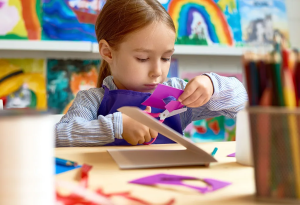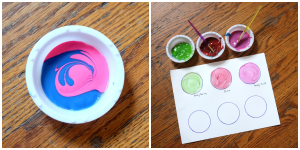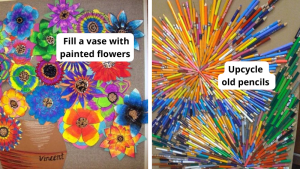Grief is a natural response to loss, and elementary school students are not exempt from experiencing it.
Whether they have lost a loved one, or a pet, or are grappling with significant life changes, young children may find it challenging to express and process their grief.
Engaging elementary students in creative grief activities can provide a safe and supportive environment for them to explore and cope with their emotions.
These activities offer an outlet for self-expression, encourage healing, and foster resilience.
We will present grief activities for elementary students, equipping them with tools to navigate their grief journey while promoting emotional well-being.
Memory Collage:

Creating a memory collage can be a powerful activity for elementary students to honor and remember their lost loved ones. Provide each student with a piece of construction paper or a small canvas, along with magazines, photographs, and art supplies. Encourage them to cut out or draw images and words that remind them of their loved ones. They can arrange these pieces on their paper or canvas, creating a collage that represents the memories and feelings associated with their loss. This activity allows students to express their emotions visually and offers a tangible reminder of their loved one’s presence in their lives.
Virtual Memory Wall:

Create a virtual memory wall using a digital platform or a classroom bulletin board. Invite elementary students to contribute digital drawings, photographs, or short messages about their loved ones. The memory wall can be a shared space where students can visit and interact, leaving supportive comments for their peers’ contributions. This virtual activity fosters a sense of community and allows students to share their memories and feelings with their classmates, even if they can’t be physically together.
Memory Jar:

A memory jar is a creative and interactive activity that helps elementary students collect and preserve memories of their loved ones. Provide each student with a small, transparent jar and strips of colorful paper. Instruct them to write down their favorite memories or moments with their loved ones on the paper and fold it up before placing them in the jar. Encourage them to decorate the jar with ribbons, stickers, or personal mementos. This activity allows students to actively engage with their memories, capturing them in a physical form that they can revisit whenever they feel the need for comfort or connection.
Related: 20 Brilliant Eye Contact Games for Kids
Emotion Art:

Elementary students often struggle with articulating their emotions during the grieving process. Engaging them in emotion art activities can provide a creative outlet for their feelings. Set up an art station with various art supplies, such as paints, markers, and colored pencils. Ask students to choose colors and shapes that represent their emotions surrounding their loss. Encourage them to create abstract or symbolic artwork that reflects their feelings. This activity promotes emotional expression and allows students to visually explore and communicate their complex emotions in a non-verbal manner.
Memory Garden:

Creating a memory garden can be a therapeutic and calming activity for elementary students dealing with grief. Find a suitable outdoor space or designate an indoor area for the garden. Provide small pots, soil, and flower seeds or seedlings. Instruct students to plant flowers or plants that remind them of their loved ones or symbolize their emotions. Encourage them to care for the plants by watering and nurturing them. This activity not only offers a physical space for reflection and remembrance but also teaches students about growth, resilience, and the cycle of life. It can serve as a peaceful and comforting place for students to visit whenever they need a moment of solace.
Related: 20 Incredible Sensory Bags for Toddlers & Babies
Feelings Journal:

Provide each elementary student with a personal journal where they can write and draw about their feelings related to their grief. Encourage them to express their emotions freely, whether it’s through writing, drawing, or a combination of both. This activity promotes self-reflection and emotional awareness, allowing students to process their grief in a private and introspective way. They can choose to share their entries or keep them as personal reflections to track their progress and growth over time.
Memory Bracelets:

Memory bracelets provide a tangible reminder of a loved one and can serve as a comforting keepsake for elementary students. Provide beads, strings, and charms for each student to create their own memory bracelet. Encourage them to choose beads or charms that represent their loved one or symbolize their relationship. As they string the beads together, they can reflect on their memories and emotions. Wearing the memory bracelet can offer a sense of connection and provide comfort during difficult times.
Music and Movement:

Engaging in music and movement activities can help elementary students channel their emotions and find release from grief. Play a selection of songs that evoke different feelings related to lose and encourage students to express themselves through dance, movement, or even simple hand motions. Provide space for them to move freely and express their emotions without judgment. This activity allows students to connect with their bodies, release pent-up emotions, and experience the healing power of music and movement.
Comfort Boxes:

Comfort boxes are personalized containers filled with comforting items that bring solace during times of grief. Provide small boxes or containers and encourage elementary students to decorate and personalize them. Inside the boxes, they can place items that bring them comfort, such as small toys, photographs, notes, or objects that remind them of their loved ones. This activity offers a physical space where students can store their treasures and access them whenever they need a source of comfort and support.
Gratitude Wall:

Gratitude can be a powerful tool in navigating grief and finding moments of positivity. Create a gratitude wall in the classroom where students can write or draw things they are grateful for, despite their loss. Provide sticky notes or small cards for them to write their thoughts and attach them to the wall. Encourage students to read the messages left by their peers and find inspiration in the shared expressions of gratitude. This activity fosters a sense of community, resilience, and appreciation for the good things in life, even amidst difficult times.
Symbolic Release:

Symbolic release activities can help elementary students let go of their grief and find closure. Provide each student with a biodegradable balloon or a piece of paper. Instruct them to write or draw their feelings or memories related to their loss on the balloon or paper. Then, have them release the balloon into the sky or tear up the paper and scatter the pieces in a natural environment. This activity symbolizes the act of letting go and allows students to express their desire for healing and moving forward.
Feelings Charades:

Engage elementary students in a game of feelings charades to help them identify and express various emotions associated with grief. Write down different emotions on separate cards and place them in a hat or bowl. Have students take turns drawing a card and acting out the emotion without using words, while their classmates guess the emotion. This activity encourages students to explore different feelings, recognize them in themselves and others, and promote empathy and understanding.
Memory Box:

A memory box provides a physical space for elementary students to store and preserve mementos and keepsakes related to their loved one. Provide each student with a small box and art supplies for decoration. Encourage them to personalize their memory box with drawings, photographs, or written messages. They can then fill the box with items that hold significance or trigger memories of their loved one. This activity offers a tangible and personal way for students to remember and cherish their connection to their loved one.
Collaborative Art Project:

Engage elementary students in a collaborative art project where they work together to create a meaningful piece of artwork. Provide a large canvas or a mural-sized paper and various art supplies. Ask students to contribute by drawing or painting something that represents their loved one or their feelings about their loss. This activity fosters teamwork, allows students to contribute their unique perspectives, and results in a collective art piece that symbolizes their shared experiences and support for one another.
Nature Walk and Reflection:

Take elementary students on a nature walk to provide a peaceful and reflective setting for them to process their grief. Encourage them to observe their surroundings, focusing on the beauty and tranquility of nature. After the walk, gather in a quiet area and invite students to share their thoughts and feelings about their loss. This activity connects students with the healing power of nature, promotes mindfulness, and creates an open and supportive space for them to express their emotions.
Emotion Walk:

Take elementary students on an emotion walk in a safe and open outdoor area. Ask them to walk silently and observe their surroundings, paying attention to how different elements in nature evoke various emotions within them. After the walk, gather as a group and discuss the emotions they experienced and why certain things triggered those feelings. This activity encourages students to connect with nature, heighten their emotional awareness, and recognize the interconnectedness between their internal emotions and the external world.
“Dear Diary” Letters:

Encourage elementary students to write “Dear Diary” letters as a way to express their thoughts, feelings, and memories about their loved ones. Provide them with notebooks or writing papers and encourage them to write letters addressed to their loved ones, sharing their thoughts, emotions, and updates on their lives. Writing these letters offers an outlet for self-expression and provides a sense of connection and communication with their loved ones, even if they are no longer physically present.
Feelings Sculptures:

Provide clay or playdough for students to create feelings sculptures that represent their emotions related to grief. Instruct them to mold the clay or playdough into shapes and forms that symbolize different feelings they are experiencing. Encourage them to experiment with textures, colors, and shapes to express the intensity and complexity of their emotions. This activity allows students to engage in tactile exploration and transform their abstract emotions into tangible representations.
Sensory Bottles:

Sensory bottles can provide a calming and soothing experience for elementary students during times of grief. Fill clear plastic bottles with different materials such as colored water, glitter, beads, or small objects. Seal the bottles tightly. Encourage students to shake the bottles gently and observe the mesmerizing patterns and movements inside. This activity promotes mindfulness and relaxation, offering a sensory outlet for students to find comfort and emotional stability.
Mindful Coloring:

Introduce elementary students to the practice of mindful coloring as a soothing and meditative activity for grief processing. Provide coloring sheets or mandalas with intricate designs and a variety of coloring materials. Instruct students to focus on the present moment as they color, paying attention to the sensation of the materials and the movements of their hands. Encourage them to let their emotions flow through the colors and patterns they choose. This activity promotes relaxation, and concentration, and allows students to channel their grief into a creative outlet.


